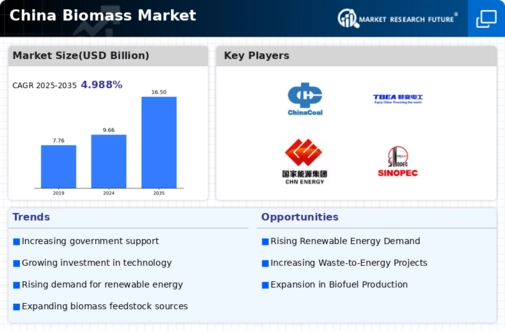The biomass market in China is characterized by a dynamic competitive landscape, driven by increasing energy demands and a strong governmental push towards renewable energy sources. Key players such as China National Biomass Energy Co (CN), China Huadian Corporation (CN), and China National Petroleum Corporation (CN) are at the forefront of this sector. These companies are strategically positioned to leverage innovation and partnerships to enhance their operational capabilities. For instance, China National Biomass Energy Co (CN) focuses on expanding its biomass power generation capacity, while China Huadian Corporation (CN) emphasizes technological advancements in biomass conversion processes. Collectively, these strategies contribute to a competitive environment that is increasingly focused on sustainability and efficiency.
In terms of business tactics, companies are localizing manufacturing and optimizing supply chains to enhance operational efficiency. The market structure appears moderately fragmented, with several players vying for market share. However, the influence of major companies is significant, as they set benchmarks for operational excellence and innovation. This competitive structure fosters an environment where smaller firms may struggle to keep pace with the technological advancements and capital investments made by larger entities.
In November 2025, China Huadian Corporation (CN) announced a partnership with a leading technology firm to develop advanced biomass gasification technologies. This strategic move is likely to enhance their operational efficiency and reduce emissions, aligning with national sustainability goals. The collaboration underscores the importance of technological innovation in maintaining competitive advantage in the biomass sector.
In October 2025, China National Petroleum Corporation (CN) launched a new initiative aimed at integrating biomass into its existing energy portfolio. This initiative is expected to diversify their energy sources and reduce reliance on fossil fuels, reflecting a broader trend towards renewable energy integration. Such actions may position the company favorably in a market increasingly driven by environmental considerations.
In September 2025, China Resources Power Holdings Company Limited (CN) expanded its biomass energy projects in rural areas, focusing on local feedstock utilization. This expansion not only supports local economies but also enhances the sustainability of their operations. By tapping into local resources, the company is likely to improve its supply chain resilience and reduce transportation costs, which is crucial in a competitive market.
As of December 2025, current trends in the biomass market indicate a strong emphasis on digitalization, sustainability, and the integration of artificial intelligence in operational processes. Strategic alliances are becoming increasingly vital, as companies seek to pool resources and expertise to navigate the complexities of the market. Looking ahead, competitive differentiation is expected to evolve, with a shift from price-based competition to a focus on innovation, technology, and supply chain reliability. This transition may redefine the competitive landscape, compelling companies to invest in cutting-edge solutions to meet the growing demands of a sustainable energy future.















Leave a Comment